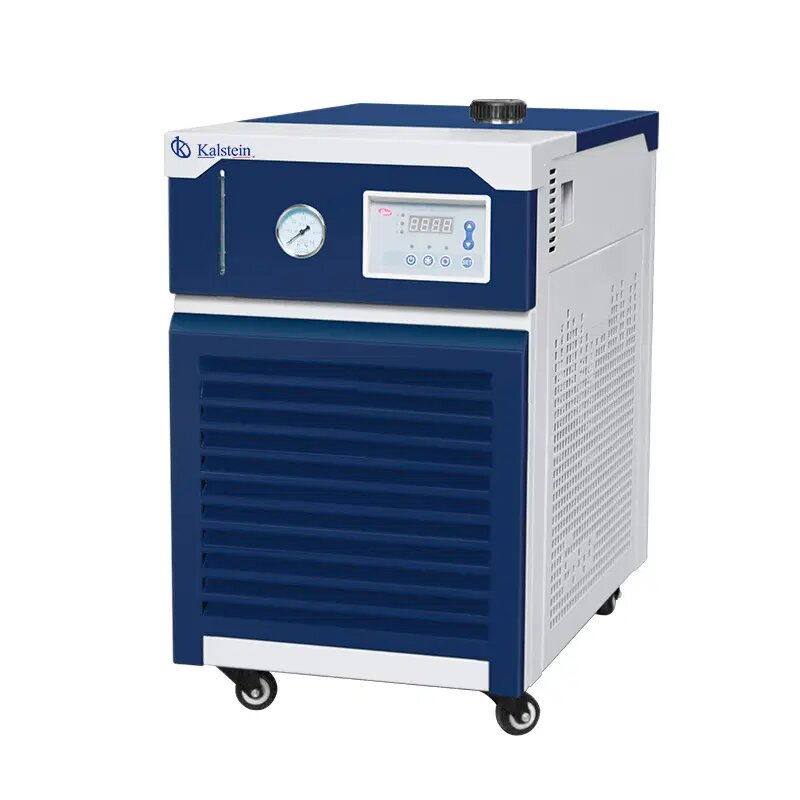The laboratory recirculating chiller is an essential piece of equipment for any laboratory that needs to maintain precise temperature control in its experiments and processes. This device not only ensures thermal stability but also contributes to energy efficiency and resource savings. In this article, we will explore in detail the features, advantages, and disadvantages of laboratory recirculating chillers and compare them with the products of notable competitors such as Wiener Lab, Labware, and Sartorius.
What is a Laboratory Recirculating Chiller?
A laboratory recirculating chiller is a device designed to maintain a constant temperature in experimental equipment and processes. It uses a closed-loop system of refrigerant liquid that circulates through a cooling system and then recirculates to maintain the desired temperature.
These devices are fundamental in various fields of research and industrial applications, as they allow precise thermal control, which is crucial for the reproducibility and accuracy of experimental results. Additionally, recirculating chillers are known for their energy efficiency, minimizing the consumption of water and electricity.
Advantages of Using a Recirculating Chiller
Precise Temperature Control
One of the main advantages of recirculating chillers is their ability to maintain exact temperatures over long periods. This is especially important in experiments where small temperature variations can significantly affect the results. The advanced thermal control technology incorporated into these devices ensures stability that other cooling methods cannot offer.
Energy Efficiency and Resource Savings
Recirculating chillers are designed to be energy-efficient. They use modern refrigeration systems that consume less electricity and reduce water usage compared to traditional cooling systems. This not only contributes to the conservation of natural resources but also reduces the operational costs of the laboratory.
Applications of Recirculating Chillers in the Laboratory
Scientific and Biomedical Research
In scientific and biomedical research, maintaining controlled temperatures is crucial. Recirculating chillers are used in a wide range of applications, from the preservation of biological samples to temperature regulation in laboratory equipment such as electron microscopes and chemical reactors.
Industrial and Manufacturing Processes
In addition to their use in research laboratories, recirculating chillers are essential in industrial processes that require precise thermal control, such as pharmaceutical manufacturing and the semiconductor industry. These devices help maintain optimal temperature conditions, ensuring the quality and consistency of the final product.
Competitor Comparison
Below is a comparative table of the laboratory recirculating chillers offered by Wiener Lab, Labware, and Sartorius compared to Kalstein’s product.
|
Characteristic |
Kalstein |
Wiener Lab |
Labware |
Sartorius |
|
Temperature Precision |
±0.1°C |
±0.2°C |
±0.1°C |
±0.1°C |
|
Cooling Capacity |
500W |
450W |
480W |
500W |
|
Energy Consumption |
200W |
220W |
210W |
200W |
|
Temperature Range |
-10°C to 40°C |
-5°C to 35°C |
-10°C to 40°C |
-10°C to 40°C |
|
Energy Efficiency |
High |
Medium |
High |
High |
Frequently Asked Questions
What maintenance is required for a recirculating chiller?
Maintenance of a recirculating chiller is relatively simple but crucial for its optimal operation. It is recommended to clean the filters regularly, check refrigerant levels, and perform periodic system inspections to ensure there are no leaks or obstructions.
Is it necessary to use a specific refrigerant liquid?
Yes, it is important to use the refrigerant liquid recommended by the chiller manufacturer. This ensures the efficiency and longevity of the equipment. Some chillers are compatible with various types of refrigerants, but it is always best to follow the manufacturer’s recommendations to avoid problems.
How noisy are these devices?
Modern recirculating chillers are designed to operate with minimal noise levels. However, the noise level can vary depending on the model and capacity of the chiller. It is advisable to check the equipment specifications before purchasing if noise level is a concern.
Can they be used in outdoor applications?
Most recirculating chillers are designed for indoor use. However, there are specific models that can be adapted for outdoor applications, provided that adequate measures are taken to protect the equipment from weather conditions and other environmental factors.
The laboratory recirculating chiller is an indispensable tool for any laboratory seeking precision and efficiency in temperature control. With significant advantages such as thermal precision, energy efficiency, and versatility in applications, these devices excel in scientific research and industrial processes. Although they require an initial investment and regular maintenance, the long-term benefits make them worthwhile. Compared to competitors like Wiener Lab, Labware, and Sartorius, Kalstein’s products offer an excellent balance between performance and cost, making them a preferred choice for many professionals in the field.
If you want to explore the high-end product catalog we have for you at Kalstein, visit us at https://kalstein.de/category-product/laboratory-line/recirculating-chiller/. We assure you that through our easy and feasible online PURCHASE channels, you will find the best prices on the MARKET. We remind you that at Kalstein, we MANUFACTURE high-level Laboratory Equipment for SALE. https://kalstein.de/

